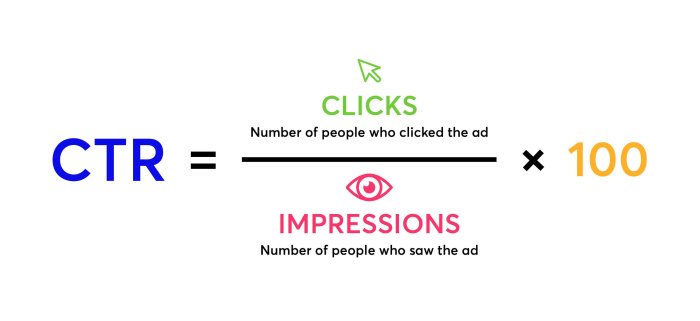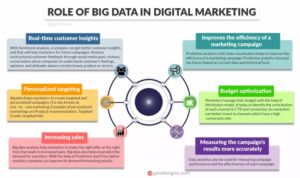Maximizing Click-Through Rate is key to crushing your online ad game. Get ready to dive into killer strategies and tools to skyrocket your CTR like a boss.
Let’s unlock the secrets to dominating the digital marketing world with high CTR rates and watch your conversions reach new heights.
Maximizing Click-Through Rate
Click-Through Rate (CTR) is a metric used in digital marketing to measure the ratio of users who click on a specific link to the number of total users who view a page, email, or advertisement. It is crucial in determining the effectiveness of online campaigns.
Maximizing CTR is essential for online advertising campaigns because it directly impacts the success of these campaigns. A high CTR indicates that the ad is resonating with the target audience and driving engagement. This not only increases brand visibility but also leads to higher chances of conversions.
Impact of a High CTR on Conversions and Overall Campaign Success
Having a high CTR can significantly improve conversions as it means more users are interacting with the ad and taking the desired action, such as making a purchase or signing up for a service. This leads to a higher return on investment (ROI) for the advertiser and contributes to the overall success of the campaign.
Strategies for Maximizing CTR

To enhance the Click-Through Rate (CTR) of your ads, it’s crucial to implement effective strategies that can attract more clicks and engagement. Here are some key tactics to optimize your ad copy, utilize compelling visuals, and target the right audience to improve CTR rates.
Optimizing Ad Copy, Maximizing Click-Through Rate
Creating engaging and relevant ad copy is essential to grab the attention of your target audience and entice them to click on your ad. Here are some strategies to optimize your ad copy:
- Highlight unique selling points of your product or service
- Use action-oriented language to prompt users to take action
- Include a clear call-to-action (CTA) to direct users on what to do next
- Experiment with different headlines and descriptions to see what resonates best with your audience
Utilizing Compelling Visuals
Visual elements can significantly impact the performance of your ads by capturing the attention of users and conveying information more effectively. Here’s why compelling visuals are crucial:
- Images and videos can help tell a story and evoke emotions in viewers
- Eye-catching graphics and high-quality visuals can make your ad stand out among competitors
- Visual content is processed faster by the brain, making it more memorable for users
Targeting the Right Audience
Reaching the right audience with your ads is essential to maximize CTR and increase the likelihood of conversions. Here’s why targeting the right audience is key:
- Understanding your target demographic allows you to tailor your ad content to resonate with their needs and interests
- Utilizing audience targeting options provided by ad platforms can help you reach users who are more likely to engage with your ads
- Personalizing your ad messaging based on audience segments can lead to higher CTR and improved overall performance
A/B Testing for CTR Optimization
A/B testing is a method used to compare two versions of a webpage or element to determine which one performs better in terms of click-through rate (CTR). By testing variations of different elements, marketers can optimize for maximum user engagement and conversion rates.
Elements for A/B Testing
- Headlines: Test different wording, length, and styles to see which one attracts more clicks.
- Call-to-Action (CTA) Buttons: Experiment with colors, text, size, and placement to increase CTR.
- Images: Try different images to see which ones resonate better with your audience.
- Ad Copy: Test variations in ad text to determine which one drives more clicks.
Best Practices for A/B Testing
- Define Clear Objectives: Set specific goals for your A/B test to measure success accurately.
- Test One Element at a Time: Isolate variables to understand the impact of each change on CTR.
- Use Statistical Significance: Ensure you have enough data to make valid conclusions from your test results.
- Run Tests Simultaneously: Avoid running tests at different times to prevent external factors from skewing the results.
- Analyze Results Thoroughly: Monitor performance metrics closely to determine the winning variation.
Tools and Analytics for Monitoring CTR

In the world of digital marketing, tracking and analyzing Click-Through Rate (CTR) data is crucial for understanding the performance of online campaigns. By using various tools and analytics, marketers can gain valuable insights that help them make informed decisions to optimize their CTR.
Popular Tools for Tracking and Analyzing CTR
- Google Analytics: A widely used tool that provides detailed insights into website traffic, including CTR data for different pages and campaigns.
- Hotjar: A tool that offers heatmaps, session recordings, and other features to track user behavior and engagement on websites.
- Crazy Egg: Another heatmap tool that helps marketers visualize how users interact with their website, highlighting areas of high and low engagement.
- Optimizely: A platform that allows for A/B testing and optimization of website elements to improve CTR based on analytics data.
- SEMrush: An tool that provides data on organic search traffic, s, and competitor analysis, which can help improve CTR through content optimization.
Interpreting CTR Analytics for Informed Decisions
When analyzing CTR data, marketers should look at metrics such as click-through rates, conversion rates, bounce rates, and engagement metrics to understand how users are interacting with their content. By identifying trends and patterns in the data, marketers can make informed decisions on optimizing their campaigns for better performance and results.
Role of Heatmaps and Other Analytics Tools in CTR Optimization
Heatmaps and other analytics tools play a crucial role in understanding user behavior on websites. Heatmaps provide visual representations of where users are clicking, scrolling, or engaging the most on a webpage, allowing marketers to optimize their layout, content, and call-to-action buttons for higher CTR. By leveraging these tools, marketers can gain valuable insights into user preferences and behaviors, ultimately leading to improved CTR and overall campaign success.
